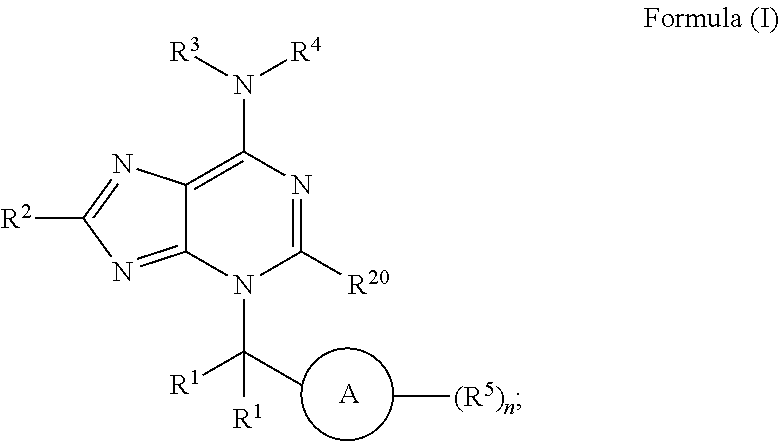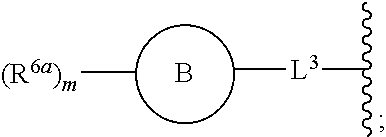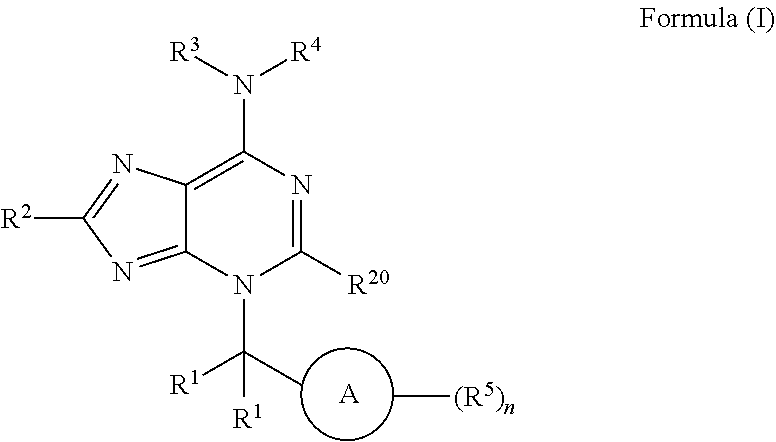Inhibitors of low molecular weight protein tyrosine phosphatase (LMPTP) and uses thereof
a low molecular weight, phosphatase technology, applied in the direction of peptide/protein ingredients, aerosol delivery, metabolism disorders, etc., can solve the problems of increasing morbidity and mortality of affected individuals, complex obesity, etc., and achieve the effect of modulating the activity level
- Summary
- Abstract
- Description
- Claims
- Application Information
AI Technical Summary
Benefits of technology
Problems solved by technology
Method used
Image
Examples
example 1
ichloro-benzyl)-3H-purin-6-yl]-furan-2-ylmethyl-amine
[0539]
Step 1
[0540]A mixture of 6-chloro-9H-purine (2 g, 13 mmol), C-furan-2-yl-methylamine (1.51 g, 15.6 mmol) and DIEA (4.7 mL, 26 mmol) in nBuOH (50 mL) was stirred and heated at 100° C. for 16 hrs. Solvent was removed and the residue was slurried with water (30 mL×2) and EA (10 mL×2) and filtered, dried over vacuum to give furan-2-ylmethyl-(9H-purin-6-yl)-amine (2.7 g, yield: 96%) as a brown solid.
[0541]1H NMR (400 MHz, DMSO-d6): δ=12.97 (s, 1H), 8.21 (s, 1H), 8.12 (br, 2H), 7.55 (s, 1H), 6.36 (s, 1H), 6.23 (s, 1H), 4.70 (brs, 2H). MS: m / z 216.0 (M+H+).
Step 2
[0542]A mixture of furan-2-ylmethyl-(9H-purin-6-yl)-amine (216 mg 1 mmol) and 1,3-dichloro-2-chloromethyl-benzene (195 mg, 1 mmol) in DMF (3 mL) was heated at 110° C. for 16 hrs. The mixture was cooled and filtered. The filtrate was purified by prep-HPLC (NH4OAc system) to give the desired [3-(2,6-dichloro-benzyl)-3H-purin-6-yl]-furan-2-ylmethyl-amine (50 mg, yield: 13.4%) ...
example 2
ichloro-benzyl)-3H-purin-6-yl]-(3-methoxy-propyl)-amine
[0545]
Step 1
[0546]A mixture of 6-chloro-3H-purine (300 mg, 1.94 mmol) and 3-methoxy-propylamine (200 mg, 2.5 mmol) in butan-1-ol (5 mL) was stirred and heated at 100° C. for 16 hrs. Solvent was removed and the residue was slurried with EA (20 mL×3), filtered to give (3-methoxy-propyl)-(3H-purin-6-yl)-amine (400 mg, yield: 100%) as a yellow solid. MS: m / z 208.0 (M+H+).
Step 2
[0547]A mixture of (3-methoxy-propyl)-(3H-purin-6-yl)-amine (200 mg, 0.96 mmol) and 1,3-dichloro-2-chloromethyl-benzene (188 mg, 0.96 mmol) in DMF (3 mL) was stirred and heated at 110° C. for 16 hrs. The reaction mixture was cooled and filtered. The filtrate was purified with prep-HPLC (NH4HCO3) to give [3-(2,6-dichloro-benzyl)-3H-purin-6-yl]-(3-methoxy-propyl)-amine (7.5 mg, yield: 16%) as a white solid.
[0548]1H NMR (400 MHz, DMSO-d6): δ=8.49-8.28 (m, 1H), 8.19-8.03 (m, 1H), 7.71-7.68 (m, 1H), 7.56-7.54 (m, 2H), 7.47-7.43 (m, 1H), 5.76-5.71 (m, 2H), 4.02-4.01...
example 3
ichloro-benzyl)-3H-purin-6-yl]-ethyl-amine
[0550]
Step 1
[0551]A vial charged with 6-chloro-3H-purine (300 mg, 1.95 mmol) and ethylamine (33% in alcohol, 0.5 mL) in EtOH (4 mL) was sealed and heated at 70° C. for 16 hrs. The mixture was cooled and filtered to give ethyl-(9H-purin-6-yl)-amine (210 mg, yield: 65%) as a white solid. MS: m / z 164.1 (M+H+).
Step 2
[0552]A mixture of ethyl-(9H-purin-6-yl)-amine (120 mg, 0.75 mmol) and 1,3-dichloro-2-chloromethyl-benzene (150 mg, 0.75 mmol) in DMF (3 mL) was stirred and heated at 110° C. for 16 hrs. The reaction mixture was cooled and kept in a refrigerator for 2 hrs. The precipitate was filtered and washed with MeCN (2 mL×2), dried over vacuum to give [3-(2,6-dichloro-benzyl) 3H-purin-6-yl]-ethyl-amine (92 mg, HCl salt, yield: 39%) as a white solid.
[0553]1H NMR (400 MHz, DMSO-d6): δ=14.19 (s, 1H), 10.25-10.22 (m, 1H), 8.80 (s, 1H), 8.54 (s, 1H), 7.60-7.54 (m, 2H), 7.48-7.44 (m, 1H), 5.88 (s, 2H), 3.71-3.64 (m, 2H), 1.29-1.23 (m, 3H). MS: m / z 32...
PUM
 Login to View More
Login to View More Abstract
Description
Claims
Application Information
 Login to View More
Login to View More - R&D
- Intellectual Property
- Life Sciences
- Materials
- Tech Scout
- Unparalleled Data Quality
- Higher Quality Content
- 60% Fewer Hallucinations
Browse by: Latest US Patents, China's latest patents, Technical Efficacy Thesaurus, Application Domain, Technology Topic, Popular Technical Reports.
© 2025 PatSnap. All rights reserved.Legal|Privacy policy|Modern Slavery Act Transparency Statement|Sitemap|About US| Contact US: help@patsnap.com



